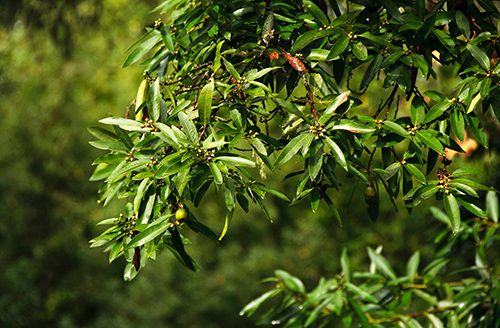Contents
In Rome, the laurel plant was dedicated to Apollo, the god in charge of triumph, fine arts, and medicine, who was an archetype of male beauty. Roman emperors, athletes, and victorious warriors wore laurel wreaths on their heads, which were supposed to protect them from lightning and evil forces. However, those wreaths proved ineffective some centuries later when barbarians conquered the Roman Empire.

Contrary to superstition regarding plant properties, the famous Spanish physician Andres de Laguna told of an incident in 1539 in Rome when he was “in the palace of the Duke of Castro, lightning struck a beautiful laurel tree which still today is wounded and broken.” Then he finished, “There is no house strong enough, nor anything effective enough to defend us from God’s judgment.”
Laurel Plant Scientific Facts
- Other names: Bay, bay laurel, bay tree, Grecian laurel, Indian bay, Roman laurel, sweet bay.
- French: Laurier.
- Spanish: Laurel.
- Environment: Native to Mediterranean countries, the laurel plant grows in coastal regions with a warm climate. It is cultivated in America.
- Description: The evergreen tree of the Lauraceae family grows from two to eight meters high. It has lanceolate, coriaceous leaves, bright on the upper side. Its flowers are small, white or yellowish. Laurel fruit is olive-like drupes, which only female laurel trees produce.
- Parts of the plant used medicinally: The leaves and fruits.
Healing Properties and Indications

Laurel plant leaves contain a volatile essential oil which consists of 45% of cineole; they also contain tannin and a bitter component. The fruits contain 25% of fatty substances: oleic, lauric, palmitic, and linoleic acids. The essential oil is the active ingredient that confers laurel and its medicinal properties. The properties of laurel are as follows:
- Appetizer, eupeptic: It is thus recommended for people who suffer from a lack of appetite, poor digestion, and a bloated stomach.
- Mild diuretic.
- Emmenagogue (stimulates menstruation) and regulative of menstruation.
- It is antirheumatic and anti-inflammatory and very effective in external applications. Laurel oil or laurel antirheumatic balm prepared with its leaves is used for massaging stiff necks, lumbalgia, sciatica, ankle sprains, and other joint and muscle aches.
How to use Laurel
- Infusion with 20-30g of leaves per liter of water. A handful of ripe fruits can be added to achieve greater effectiveness. As an appetizer, drink a cup ten minutes before meals. As a digestive, drink a cup after each meal.
- Laurel oil: Put in cold extract for ten days under the sunlight, 30g of laurel leaves per liter of olive oil. Apply as a lotion on the painful area. This oil is also effective as an insect repellent.
- Antirheumatic balm: Mash a large handful of ripe laurel berries in a mortar, then boil water for 5 to 10 minutes. Strain with a cloth, let the liquid cool and use the floating fatty layer. This laurel fat is applied by massaging the affected area. It must never be eaten.

Cherry Laurel
The cherry laurel is a tree of the Rosaceae family, which features blackberries similar to cherries. Its leaves contain a bitter almond smell and cyanogenic glycosides, which liberate hydrocyanic acid, a poisonous substance. However, when they are distilled, cherry laurel water is obtained. The water has medicinal properties as an antiemetic (against vomiting), soothing, and antispasmodic remedy.
DISCLAIMER: All content on this website is presented solely for educational and informational objectives. Do not rely on the information provided as a replacement for advice, diagnosis, or treatment from a qualified medical expert. If you are pregnant, nursing, or have any preexisting medical concerns, talk to your doctor before using any herbal or natural medicines.
REFERENCES
- George D. Pamplona-Roger, M.D. “Encyclopedia of Medicinal Plants.” George D. Pamplona-Roger, M.D. Encyclopedia of Medicinal Plants. Ed. Francesc X. Gelabert. vols. 2 San Fernando de Henares: Editorial Safeliz, 2000. 457,458. Print. [laurel plant]
